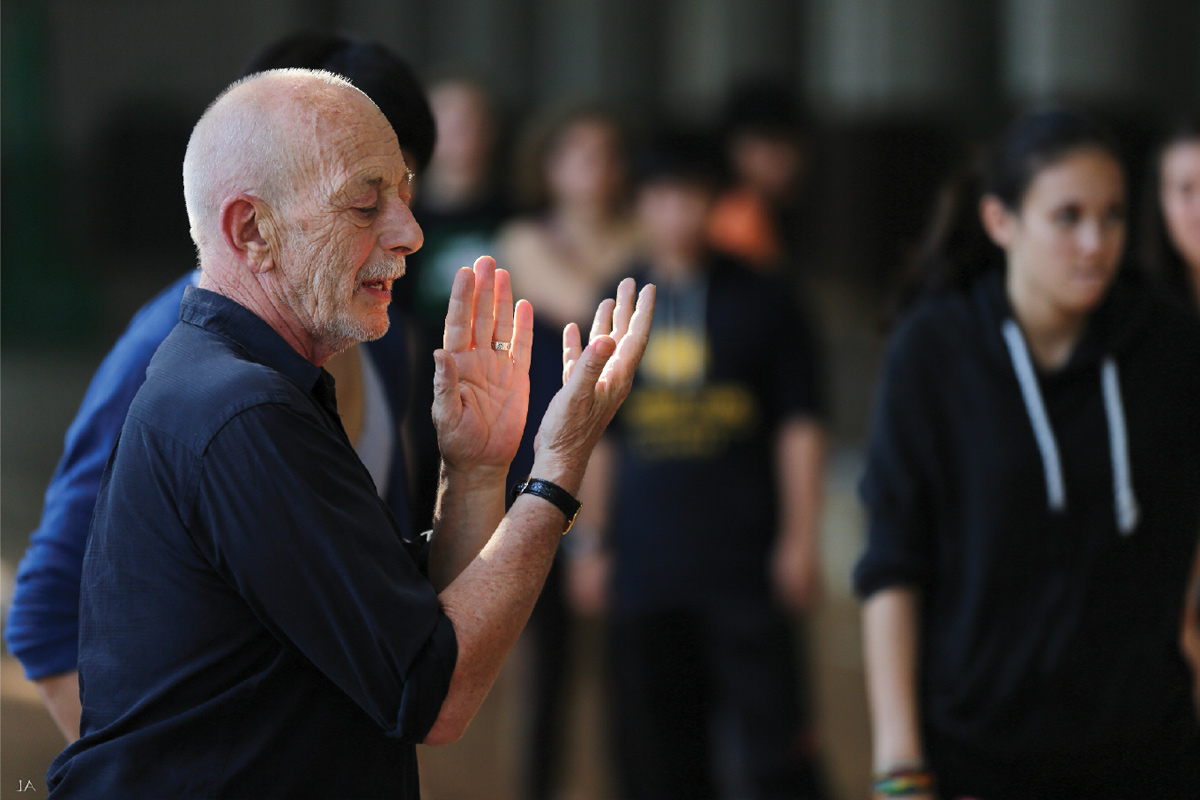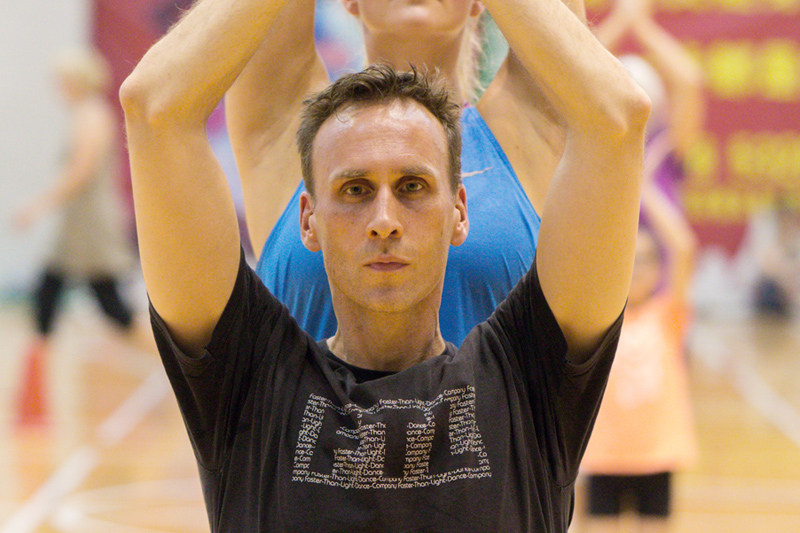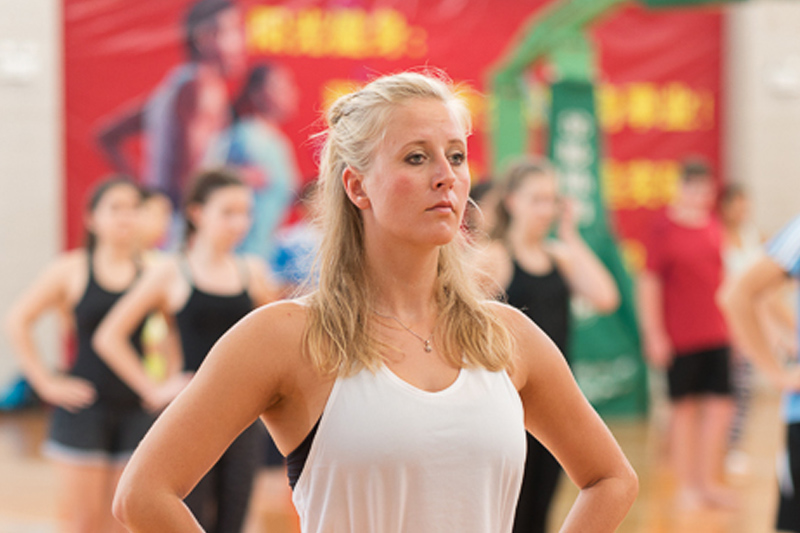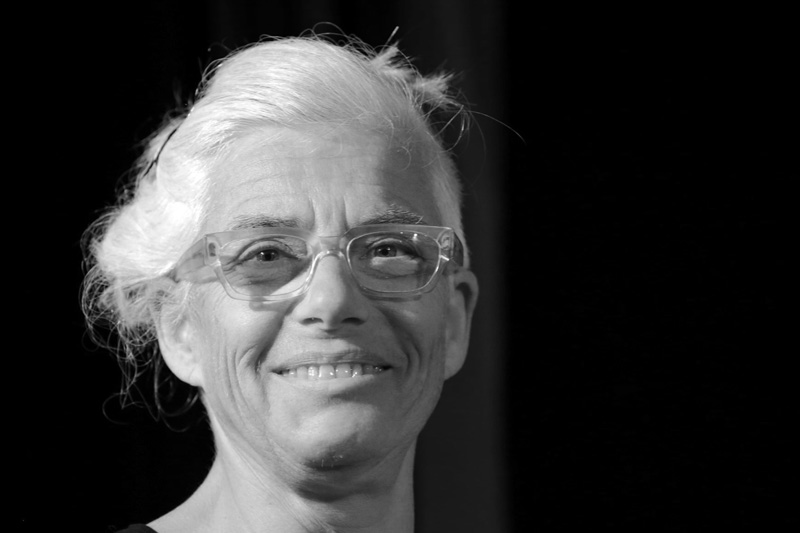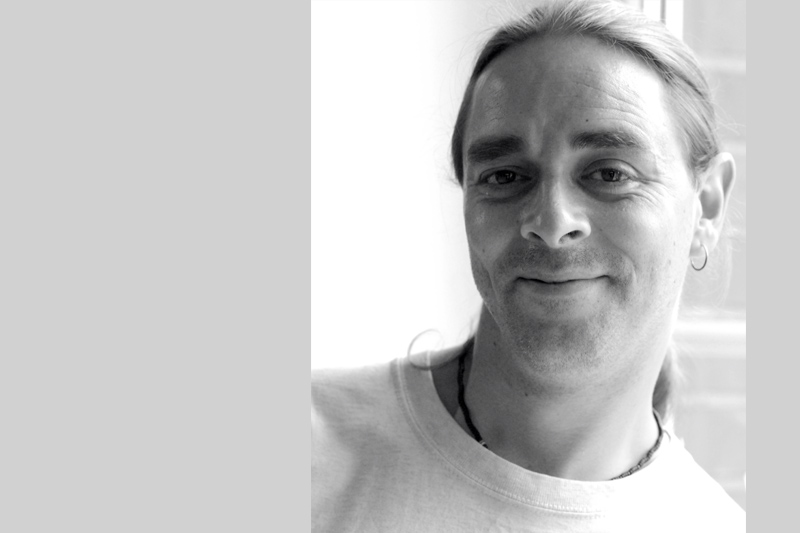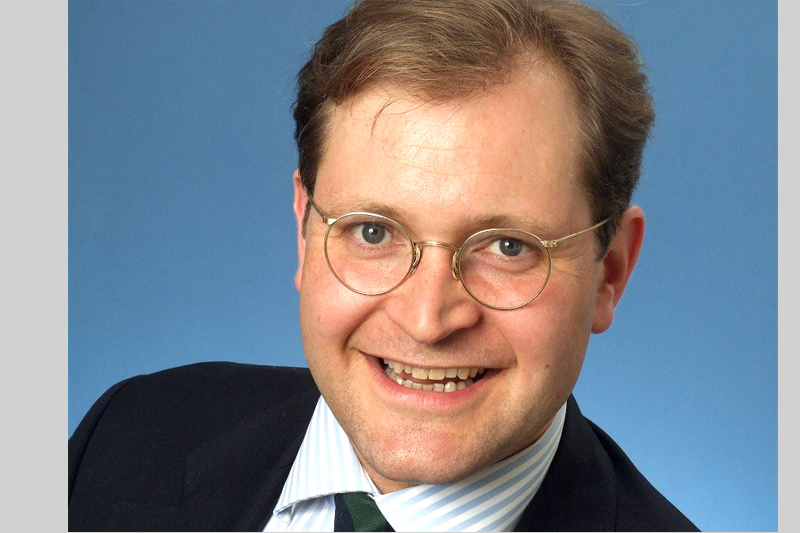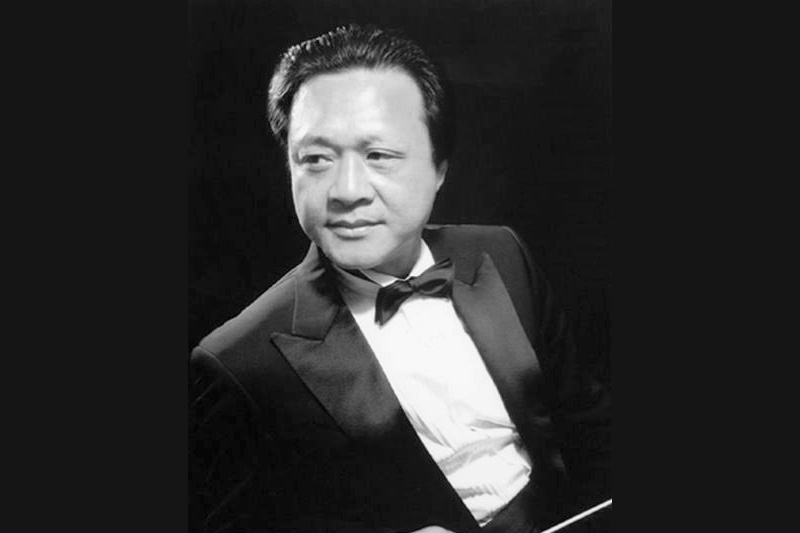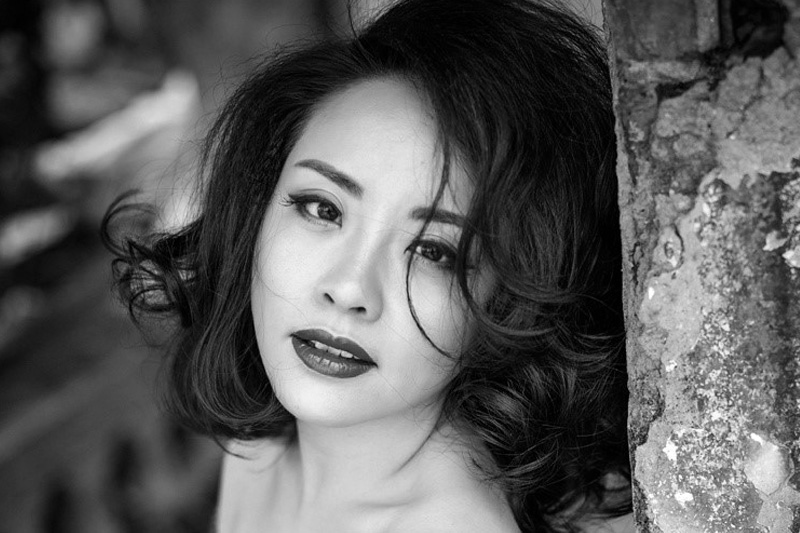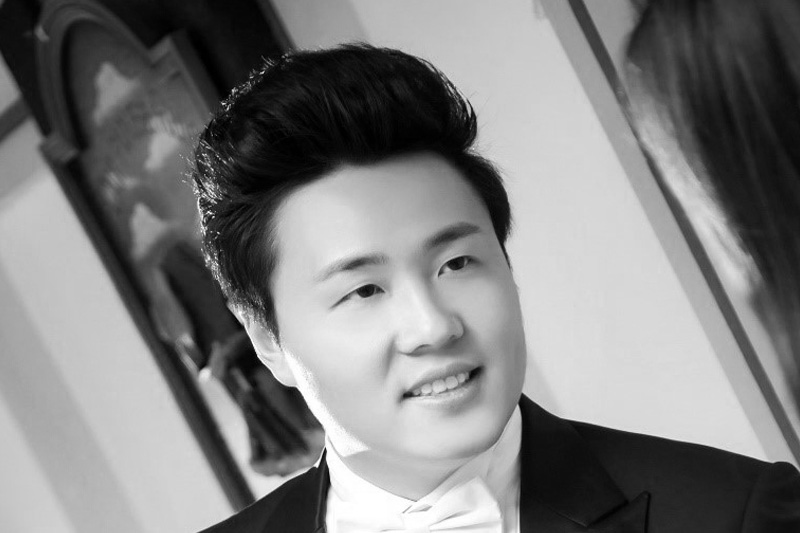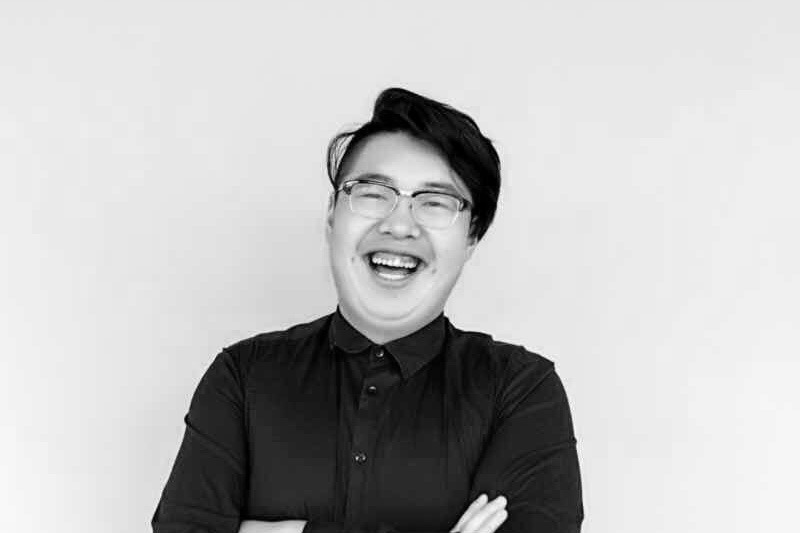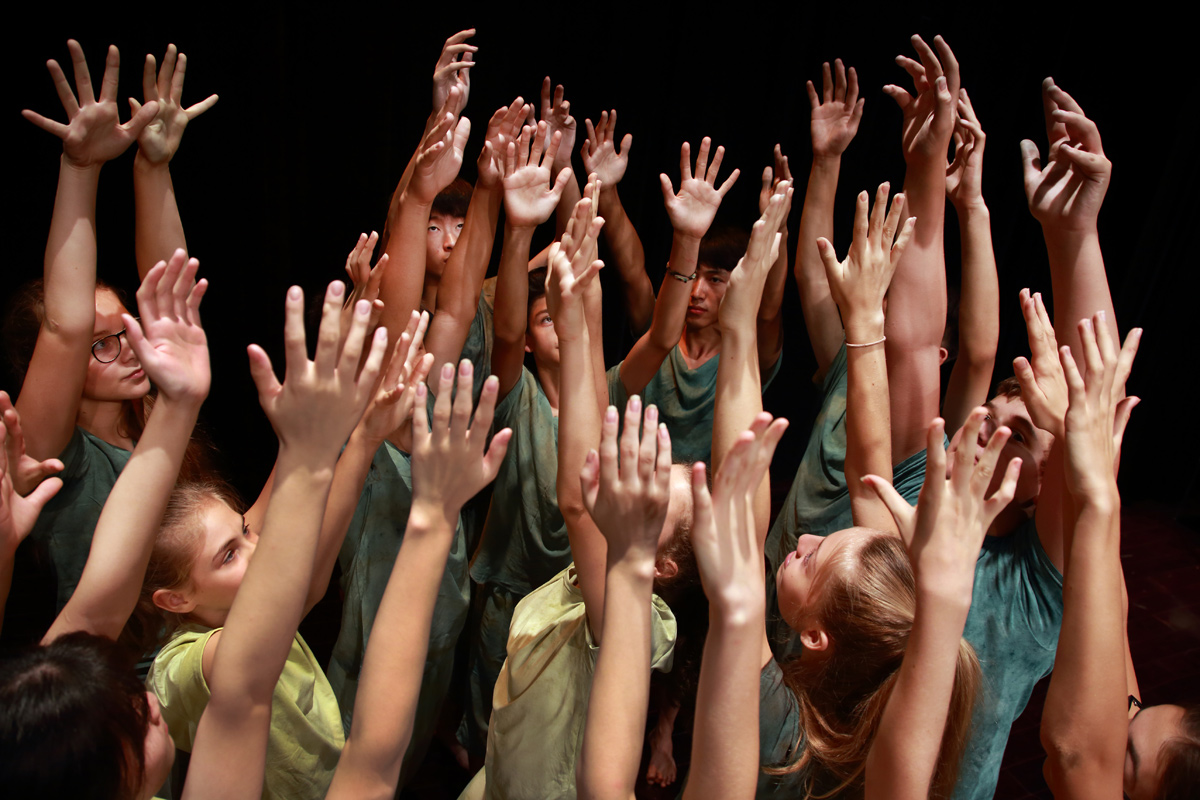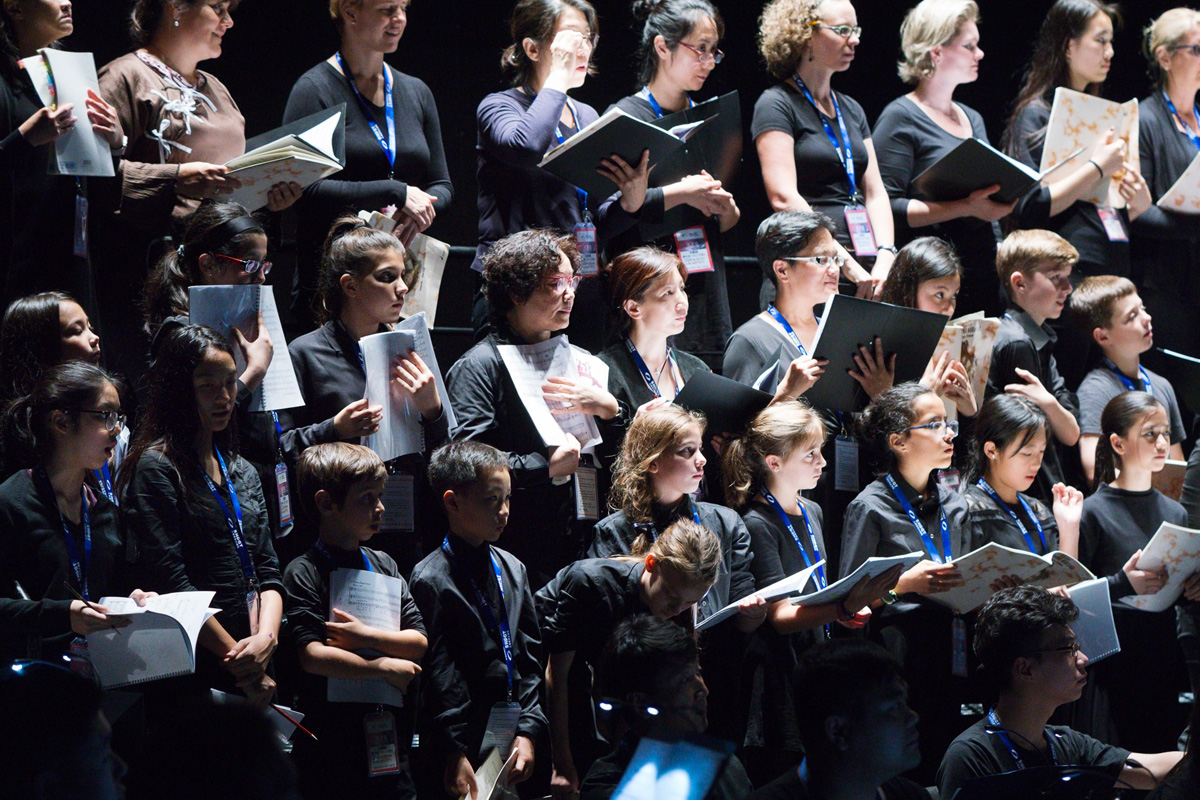On Stage
Chorus and Orchestra
Royston Maldoom, Artistic director and choreographer
Royston Maldoom is the founder of community dance and various dance projects around the world. He has initiated numerous dance projects in different countries and cooperated with a lot of dancers, regardless of gender, colors, races, social backgrounds or talents in dancing. He was awarded the Order of the British Empire (O.B.E.) by Queen Elisabeth II for his outstanding social activities and artistic workpieces.
“We do not need to talk with each other to live with each other. But once we have danced together, we can live with each other!”
Volker Eisenach, Choreographer and rehearsal director
Volker Eisenach is a freelance choreographer, youth dance director and writer and has been leading international dance project for over 20 years. Since 2003 he has worked extensively with his former teacher Royston Maldoom for projects in Europe, North America and New Zealand.
Mia Sophia Bilitza, Choreographer and rehearsal director
In 2010 Mia began assisting Royston Maldoom and others worldwide in the field of community dance. As a freelance choreographer, she creates pieces for different age and ability groups in and outside Germany. 2014 she has been curator for dance and chief choreographer in the international art festival new talents biennale cologne and has been training the professional dance company “El Funoun Palestinian Popular Dance Troupe” as well as their junior dance group this summer.
Ruth Pulgram, Costume Designer
Ruth Pulgram, born in 1954, stage and costume designer, graduated from the University of Applied Arts in her hometown of Vienna. She has been designing in the world of opera and theatre throughout Europe since 1976, including for Wiener Kammeroper, Comédie de Genève, Festival d’Avignon, Opéra de Montpellier and Festival du Marais Paris.
more
Having met choreographers in 1988, Ruth went on to develop a special interest in contemporary dance, initially collaborating on production design.
Working independently, her creative output has grown into an artistic practice of making installations concerned with the paradox of capturing movement through the execution and presentation of quick sketches. Examples include UNIL Lausanne, Biennale de la Danse Lyon, ImPulsTanz Wien and DuoSoloDanse St.Louis du Sénégal.
Now with an established international portfolio, Ruth Pulgram has travelled all over Asia, Africa and South America, exhibiting work in several countries incorporating a variety of techniques and formats. In addition to exhibitions, her drawings interpreting texts through imagery have been published in limited edition collectors’ books.
Ruth’s collaboration with Royston Maldoom and Volker Eisenach began in 2003 in the Berlin Philharmonic Orchestra’s education projects and she worked with Mia Sophia Bilitza at Cologne Opera in 2011.
Pete Ayres, Lighting Designer
Pete Ayres graduated with a B.A. (Hons.) in Technical Theatre Arts, specialising in Lighting Design. He has worked extensively in the field of Contemporary Dance, designing for Royston Maldoom for more than 15 years.
more
Pete has worked in a variety of venues – from African amphitheatres, Berlin bus depots, Croatian castles and metropolitan motorways to nationally important playhouses such as The Royal Albert Hall, The Place Theatre and The South Bank (London), Schauspielhaus (Hamburg), The Cultural Centre, Kaunas (Lithuania), and Addis Ababa City Hall (Ethiopia). He has been involved in several Community Dance projects – including orchestral productions with Berlin Philharmonic Orchestra, Russian National Orchestra, London Symphony Orchestra and Carnegie Hall in New York, among others – often including hundreds of participants, ranging from street children in Peru and groups of mixed ability performers, to Senior Citizens of Germany and young women of immigrant families.
Christian von Gehren, Conductor
Christian von Gehren, born 1972, comes from a German-Danish background and studied at Staatliche Hochschule für Musik Karlsruhe and Det Kongelig Danske Musikkonservatorium Copenhagen in the main subjects conducting, piano and musical theory. He obtained his diplomas with honours at both academies. His conducting teachers were Wolf-Dieter Hauschild and Michel Tabachnik.
more
From 2001 to 2003 Christian von Gehren was Musical Director at the Opera Leipzig. In this period he restructured the opera’s ensemble and performed in addition to the standard opera repertoire Mendelssohn’s only opera “Die Hochzeit des Camacho” with the Gewandhausorchester Leipzig in a concert version. This rediscovery had a great acclaim in the musical press and was broadcasted by the Berlin radio Deutschlandradio Kultur.
Since 2004 Christian von Gehren has been working as guest conductor in many European countries and has appeared with orchestras like Malmö Symfoniorkester, Munich Radio Orchestra and with opera theatres like Dortmund and Thessaloniki.
In 2005 he conducted Bohuslav Martinů’s opera “Greek Passion” in a production of the Royal Opera House Covent Garden in Brno/Czechia. For his conducting Christian von Gehren was named Conductor of the Year by the Czech Critics. From 1999 to 2007 Christian von Gehren had a close collaboration with the Bregenz Festival: He conducted the Vienna Symphony Orchestra in productions like Puccini‘s “La Bohème“ and “Tosca“. In 2007 he also conducted a concert with the Vienna Symphony Orchestra in the Konzerthaus Wien. At the age of 21 Christian von Gehren made his debut as an opera conductor with Carl Maria von Weber’s “Der Freischütz“ at the Zwingenberg Festival. Still being a student he started his conducting career and was as Korrepetitor und Assistant Conductor to Ulf Schirmer working with the Danish National Radio Orchestra Copenhagen and at the Bastille Opera Paris. He also was Assistant Conductor to Heinz Fricke, Michael Schønwandt, Marcello Viotti und Alberto Zedda. As a pianist he accompanied the Master Classes of Renata Scotto and Christa Ludwig as well as numerous Lied recitals.
Further engagements brought him to the Symphony Orchestras in Copenhagen, Aarhus and Aalborg, the Schleswig Holstein Music Festival, the Hessisches Staatstheater Wiesbaden,to the Operas of Copenhagen, Montpellier and Nizza and during a longer period of cooperation to the Opera Marseille. From 2000 to 2003 Christian von Gehren was Musical Director of the CNIPAL Marseille, the largest Opera Academy in France.
Christian von Gehren also conducts contemporary music and is regularly invited for productions with the Munich Radio Orchestra featuring German contemporary composers. The recordings of those productions have been broadcasted by the Bayerischer Rundfunk. In addition, Christian von Gehren recorded a CD with contemporary music for children by the German composer Franz Kanefzky, also with the Munich Radio Orchestra. He was also invited to conduct several ensembles for contemporary music in Scandinavia, Germany and France, among others Bit20 (Bergen, Norway) and Bodø Sinfonietta (Bodø, Norway).
Since 2009 Christian von Gehren has been the Musical Director of the “Orff-Akademie des Münchner Rundfunkorchesters“ and since 2010 conducting at the Carl Orff Festival Andechs / Bavaria. In 2011 he conducted a CD-production of “Sommernachtstraum“ by Carl Orff which was highly acclaimed by the critics.
In 2011 Christian von Gehren conducted “Carmina Burana“ and “Die Kluge“ at the Carl Orff Festival. This collaboration continued in 2012 with a new production of “Die Bernauerin“ and again “Die Kluge“, followed in 2013 by “Bernauerin“ and “Carmina Burana“, in 2014 additionally by “Catulli Carmina“. In 2015 Christian von Gehren conducted “Der Mond” and “Astutuli”.
Xu Hong, Conductor
Xu Hong is the permanent conductor of the National Orchestra and the current conductor and deputy head of the Anhui Symphony Orchestra. He is member of the Chinese Orchestra Alliance. He is awarded by Anhui province as one of the top notch talents in six different categories. He holds the first level of command.
more
Since 2003, Xu Hong is leading the prestigious Anhui New Year Spring Symphony Concert, performs traditional Chinese concerts and other important concerts.
In 2008 he performed with the Anhui Symphony Orchestra in the National Grand Theatre in Beijing, in 2009 he performed successfully the Chinese New Year concert in Germany, Switzerland, Austria and Egypt.
2011 he performed with the Anhui National Orchestra in the United States at Kennedy Art Centre, Lincoln Art Centre, Baltimore, Yale University and other places.
In 2011 he leaded Anhui Symphony Orchestra in the third Chinese symphonic music season and in 2013 he leaded the Anhui Symphony Orchestra to an acclaimed performance at the “Canadian–Chinese International Music Festival”.
Zhang Weihong, Soprano
Zhang Weihong is a female soprano, born in Wenzhou, Zhejiang province. She studied at the East China Normal University and moved to Germany in 2004 in order to pursue advanced studies in classical music. She majored in Opera at both the University of Music and Theatre Leipzig and University of Music Würzburg.
more
During her time in Würzburg, she studied under the guidance of the renowned female soprano, Cheryl Struder. Zhang Weihong starred in the leading female role of Don Anna in Mozart’s opera Don Juan, as well as the leading female role of Ann in Stravinsky’s opera The Rake’s Progress. Furthermore, she frequently participated in large-scale concerts, including the Mercedes Benz Christmas Concert. As the only solo singer of the Brandenburg Open Air Symphony Concert, she performed selections from Dvořák’s Rusalka. This June, Zhang Weihong made an especially successful appearance in Berlin at the Kammeroper Reisberg Summer Music Festival by impressing her audience with selections from Puccini’s opera “Madame Butterfly”. Among numerous positive reviews, one local daily newspaper praised her performance with the following words: “The Chinese female soprano Zhang Weihong also masters the art of high notes as she demonstrated on stage as the Butterfly”.
Yang Luo, Tenor
Yang Luo, born in August.1989, China, was accepted by the Voice Department Nanjing University of the Arts as an undergraduate student under the “Special talented Student” category and graduated in 2012 with the highest score among all the voice students of the department.
more
Yang performed Recitals in 2009, 2011, 2012, 2015 and 2016 respectively and took part in about 100 concerts so far. He also performed Tamino and Monostatos in “Magic Flute” for “The 2009 Seoul International Opera Program”. He performed Rodolfo in “La Bohème” at Art Center in Nanjing, 2013 and in 2014 he performed Edgardo in “Lucia di Lammermoor” at Qingdao Cultural Center.
Fu Han, Bariton
Fu Han majored in vocal music performance at the East China Normal University in 2004 and studied from Professor Cao Jin. In January 2014, he accompanied the departmental choir to the University of Cincinnati for an exchange performance. In March 2014, he participated in an art song master class taught by Ulrich Eisenlohr, the Art Director of the Cologne Music Institute in Germany. In 2015, he represented East China Normal University at numerous art and cultural exchange events, including “Night of Hong Kong” in Hong Kong.
more
Yang performed Recitals in 2009, 2011, 2012, 2015 and 2016 respectively and took part in about 100 concerts so far. He also performed Tamino and Monostatos in “Magic Flute” for “The 2009 Seoul International Opera Program”. He performed Rodolfo in “La Bohème” at Art Center in Nanjing, 2013 and in 2014 he performed Edgardo in “Lucia di Lammermoor” at Qingdao Cultural Center.
Dancers
Deutsche Schule Shanghai Eurocampus 上海德国学校欧洲校区
- Alexander Berger
- Ben Catenos
- Emanuel Catenos
- Yohann Catenos
- Livia Fiebrandt
- Joris Günther
- Antonia Hengstmann
- Nele Jung
- Bastian Kai
- Fieneke Klebsch
- Melanie Koppitz
- Paula Kroener
- Han Henry Luo
- Emma Samuel
- Fynn Samuel
- Victoria Shen
- Li Shixiao
- Frida Tang
- Greta Tang
- Henri Tang
- Moritz Tome
- Sophie Wachholz
- Steffi Wang
- Lotte Wegener
- Linda Zhang
Deutsche Schule Shanghai Pudong 上海德国学校浦东校区
- Mona Bunzel
- Anabela Dordic
- Felien Eek
- Hessel Eek
- Audrey Hartmann
- Julia Hoffmann
- Anna Hoffmann
- Sara Kaya
- Lili Kreuder
- Franca Menneking
- Melina Rauter
- Madeleine Rümpler
- Sophia Sowietzki
Lycée Français de Shanghai 上海法国学校
- Mona Amblard
- Cécilia Amegnisse
- Antoine Barbier
- Isabelle Barbier
- Lucie Barthélémy
- Alexis Benoit
- Claire Bertin
- Emma Bigot
- Alice Cavallini
- Esmé Chamarre
- Maud Champlong
- Clara Coreau
- Ada Deperrois
- Esther Devillers
- Camille Deschandol
- Colette Duriez
- Eline Fleuriau
- Thaïs Fondeville
- Aurélie Hébrard
- Kenza Ka
- Lena Ka
- Simone Kayser
- Camille Latchoumanin
- Pauline Latchoumanin
- Claire Masson
- Margaux Mille
- Philippine Mode
- Diane de Prat
- Romane de Prat
- Marine Shan
- Nicolas Shan
- Blondine Xing
Dulwich College Shanghai 上海德威英国国际学校
- Lily Beaumont-Boulanger
- Lin Chun-Yu
- Lexie Stinson
- Teoh Yi-Jing
Shanghai Caoyang No. 2 High School 上海市曹杨第二中学
- 郑宇辉
- 刑思佳
- 李思媛
- 张铭意
- 段景怡
- 顾昕炜
- 陆厚源
- 梁潇忆
- 曹诗绮
- 黄小桐
- 冯倩
- 苏雨林
- 印昕雨
- 张之尧
- 张亦君
- 赵赫轩
- 范毅
Jiangsu Taicang Secondary Vocational School 江苏太仓中等专业学校
- 李成成
- 潘宇轩
- 史超
- 王福元
- 顾伟
- 吴润洁
- 曾翔宇
- 李涛
- 缪茂仕
- 徐景鑫
- 邱嘉琛
- 马雨薇
- 李江南
- 倪家伟
- 闵一颢
- 郭冲
- 朱乙
- 陈倩宇
- 陈苏君
- 曹梦亚
- 李楠楠
- 高雯婷
- 洪桐
- 潘怡晨
- 万斯李
- 徐佳馨
- 王美兰
- 陈思怡
- 梁谭
- 吴双仟
- 张晨
- 金陶萄
- 张祎敏
Taicang Inclusion Factory 太仓中德善美实业有限公司
- 彭欣
- 黄贇
Marquardt Switches Co. Ltd. Shanghai 马夸特开关(上海) 有限公司
- 田波波
- 韩成磊
- 高悦皓
- 穆敬元
- 舒睿
- 高丽
- 罗彦
Other dancers 其他舞者
- Min Cai 蔡敏
- Yang Guang 杨光
- Christa Kröger-Wang
- Sophia Röhr
- Franziska Thiel
- Tian Tong 佟天
- Patty Winpenny
- Wu Feiyang 吴飞阳
- Ou MeiDan 欧梅丹
Chorus
Dulwich College Shanghai 上海德威英国国际学校
- Alice Adams
- Enzo Ballini
- Charlotte Demortain
- Freya Dixon
- Goj Dominika
- Elena Escobedo Pozniakova
- Chole Goss
- Isabel Goss
- Matthew Goss
- Roddy Howie
- Sarah Jiang
- Angeline Karageorgiou
- Qian Rui Liu
- Anastasia Lukic
- Mao Nakano
- Veronica Park
- Tim Parker
- Katie Parker
- Smruthi Rangarajan
- Qanita Soeradji
- Gabby Taylor
- Kara Taylor
- Yasmina Telek
- Natasha Theil
- Zara Theil
- Marina Wu
- Jason Yu
Deutsche Schule Shanghai Pudong 上海德国学校浦东校区
- Eva Beiter
- Gunhild Claessens
- Marlene Claessens
- Angelina Frenken
- Lorenz Haug
- Petra Haug
- Alex Hofmann
- Dirk Hofmann
- Elke Hofmann
- Gina Kruppe
- Stephanie Wiessner
Shanghai Conservatory of Music 上海音乐学院
- 徐伟钦 Xu WeiXing
- 刘宇翔 Liu YuXiang
- 钮结义 Niu JieYi
- 李青琰 Li QingYan
- 李响 Li Xiang
- 侯毛雨 Hou MaoYu
- 王雨童 Wang YuTong
- 谢昕宇 Xie XinYu
- 黄愉淋 Huang YuLin
- 王彦卿 Wang YanQing
- 任廷 Reng Ting
- 刘葭 Liu Jia
Shanghai International Choral League 上海国际联盟合唱团
- Duccio Alabiso
- Risaka Sophia Beddie
- Yan Qian Bei 贝彦倩
- Hado Brockmeyer
- Dan Dan Chen 陈丹丹
- Heng Feng Chen 陈恒峰
- Wen Mei Ding 丁文妹
- Hong Fan 樊红
- Claudia Gehlen
- Kae Hisano 久野加惠
- Corinne Hua
- Guo Ying Li 李国英
- Yuan Guang (Perry) Lin 林远光
- Feng Liu 刘峰
- Yang Ma 马洋
- Carol M. Schoch
- Christine Scholz
- Hanna Stehle
- Chao Ying Sun 孙超英
- Rong Rong Tang 唐蓉蓉
- Qiao Zhen Xia 夏巧珍
- Ping Qu Zhang 张平渠
- Tao Zhang 张涛
- Yu Juan Zhao 赵玉娟
- Su Shen Zhuang 庄苏申
- David Hans
- Monika Weibert
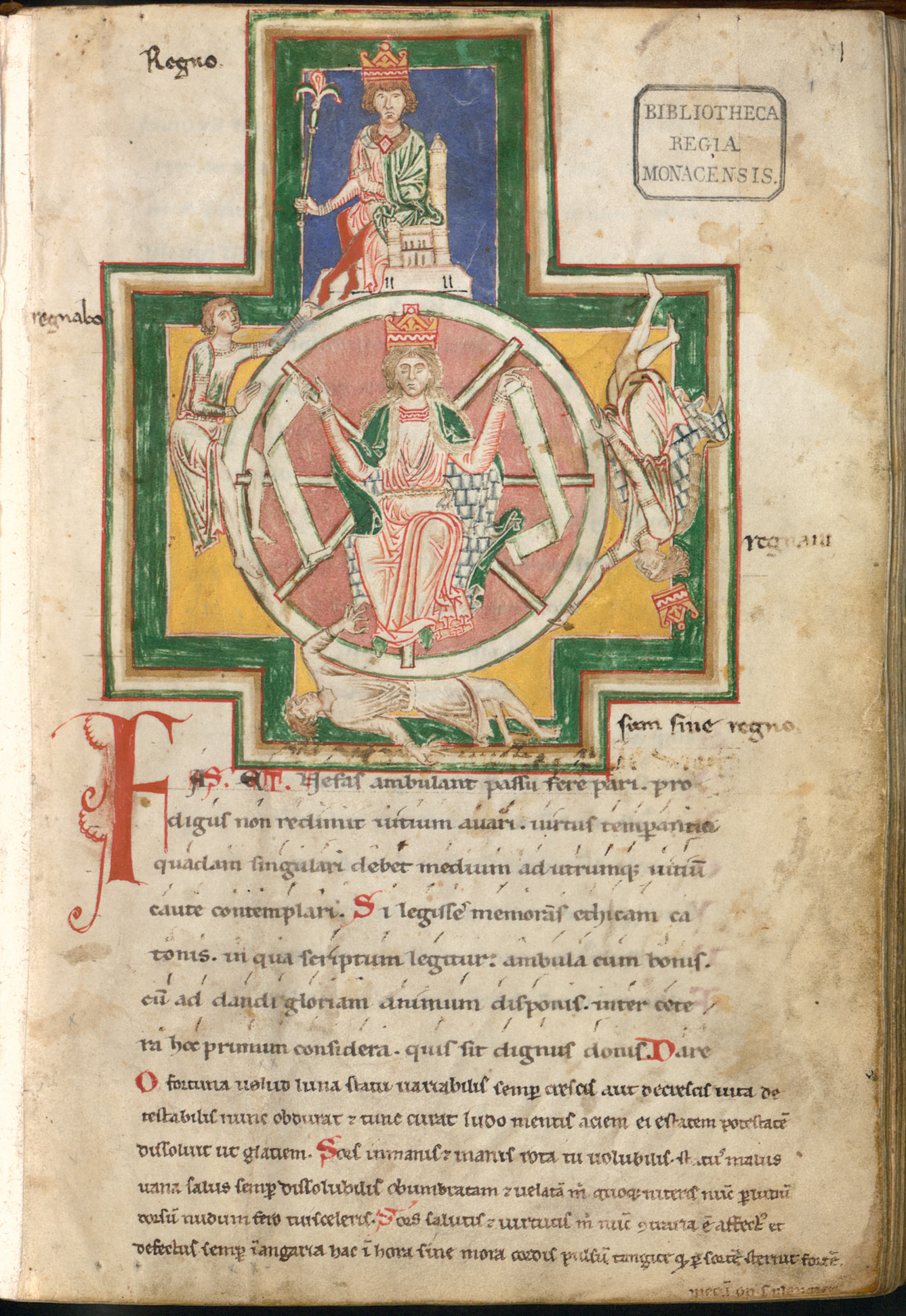
Illustration: “Wheel of Fortune”, Codex Buranus, 1230 — 14.c (image: Bayerische Staatsbibliothek, Munich)
About Carmina Burana
Carmina Burana (/ˈkɑːrmᵻnə bʊˈrɑːnə/, Latin for “Songs from Beuern”; “Beuern” is short for Benediktbeuern) is the name given to a manuscript of 254 poems and dramatic texts mostly from the 11th or 12th century, although some are from the 13th century. The pieces are mostly bawdy, irreverent, and satirical. They were written principally in Medieval Latin; a few in Middle High German, and some with traces of Old French or Provençal. Some are macaronic, a mixture of Latin and German or French vernacular.
They were written by students and clergy when the Latin idiom was the lingua franca across Italy and western Europe for travelling scholars, universities and theologians. Most of the poems and songs appear to be the work of Goliards, clergy (mostly students) who satirized the Catholic Church. The collection preserves the works of a number of poets, including Peter of Blois, Walter of Châtillon, and an anonymous poet, referred to as the Archpoet.
The collection was found in 1803 in the Benedictine monastery of Benediktbeuern, Bavaria, and is now housed in the Bavarian State Library in Munich. Along with the Carmina Cantabrigiensia, the Carmina Burana is considered to be the most important collection of Goliard and vagabond songs. The manuscripts reflect an international European movement, with songs originating from Occitania, France, England, Scotland, Aragon, Castile and the Holy Roman Empire.
Twenty-four poems in Carmina Burana were set to music by Carl Orff in 1936. Orff’s composition quickly became popular and a staple piece of the classical music repertoire. The opening and closing movement, “O Fortuna”, has been used in numerous films.




